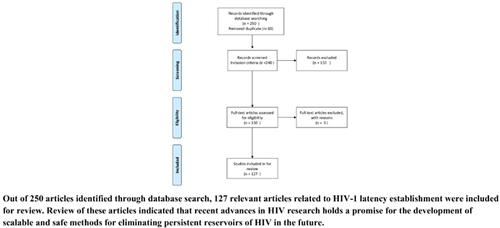Current HIV Research ( IF 0.8 ) Pub Date : 2020-12-31 , DOI: 10.2174/1570162x18999200819172009 Edward K Maina 1 , Asma A Adan 1 , Haddison Mureithi 1 , Joseph Muriuki 2 , Raphael M Lwembe 2

|
Background: During the past 35 years, highly effective ART has saved the lives of millions of people worldwide by suppressing viruses to undetectable levels. However, this does not translate to the absence of viruses in the body as HIV persists in latent reservoirs. Indeed, rebounded HIV has been recently observed in the Mississippi and California infants previously thought to have been cured. Hence, much remains to be learned about HIV latency, and the search for the best strategy to eliminate the reservoir is the direction current research is taking. A systems-level approach that fully recapitulates the dynamics and complexity of HIV-1 latency In vivo and is applicable in human therapy is prudent for HIV eradication to be more feasible.
Objectives: The main barriers preventing the cure of HIV with antiretroviral therapy have been identified, progress has been made in the understanding of the therapeutic targets to which potentially eradicating drugs could be directed, integrative strategies have been proposed, and clinical trials with various alternatives are underway. The aim of this review is to provide an update on the main advances in HIV eradication, with particular emphasis on the obstacles and the different strategies proposed. The core challenges of each strategy are highlighted and the most promising strategy and new research avenues in HIV eradication strategies are proposed.
Methods: A systematic literature search of all English-language articles published between 2015 and 2019, was conducted using MEDLINE (PubMed) and Google scholar. Where available, medical subject headings (MeSH) were used as search terms and included: HIV, HIV latency, HIV reservoir, latency reactivation, and HIV cure. Additional search terms consisted of suppression, persistence, establishment, generation, and formation. A total of 250 articles were found using the above search terms. Out of these, 89 relevant articles related to HIV-1 latency establishment and eradication strategies were collected and reviewed, with no limitation of study design. Additional studies (commonly referenced and/or older and more recent articles of significance) were selected from bibliographies and references listed in the primary resources.
Results: In general, when exploring the literature, there are four main strategies heavily researched that provide promising strategies to the elimination of latent HIV: Haematopoietic Stem-Cell Transplantation, Shock and Kill Strategy, Gene-specific transcriptional activation using RNA-guided CRISPR-Cas9 system, and Block and Lock strategy. Most of the studies of these strategies are applicable in vitro, leaving many questions about the extent to which, or if any, these strategies are applicable to complex picture In vivo. However, the success of these strategies at least shows, in part, that HIV-1 can be cured, though some strategies are too invasive and expensive to become a standard of care for all HIV-infected patients.
Conclusion: Recent advances hold promise for the ultimate cure of HIV infection. A systems-level approach that fully recapitulates the dynamics and complexity of HIV-1 latency In vivo and applicable in human therapy is prudent for HIV eradication to be more feasible. Future studies aimed at achieving a prolonged HIV remission state are more likely to be successful if they focus on a combination strategy, including the block and kill, and stem cell approaches. These strategies propose a functional cure with minimal toxicity for patients. It is believed that the cure of HIV infection will be attained in the short term if a strategy based on purging the reservoirs is complemented with an aggressive HAART strategy.
中文翻译:

消除潜伏性 HIV-1 和随后治愈 HIV-1 的当前策略回顾
背景:在过去的 35 年中,高效的 ART 通过将病毒抑制到检测不到的水平,挽救了全世界数百万人的生命。然而,这并不意味着体内没有病毒,因为 HIV 持续存在于潜伏宿主中。事实上,最近在密西西比州和加利福尼亚州的婴儿中观察到艾滋病毒反弹,这些婴儿以前认为已经治愈。因此,关于 HIV 潜伏期还有很多有待了解,寻找消除病毒库的最佳策略是当前研究的方向。一种全面概括 HIV-1 体内潜伏期的动态性和复杂性并适用于人体治疗的系统级方法对于根除 HIV 更加可行是谨慎的。
目标:已经确定了阻止抗逆转录病毒疗法治愈 HIV 的主要障碍,在了解潜在根除药物的治疗靶点方面取得了进展,已经提出了综合策略,并且各种替代方案的临床试验是进行。本次审查的目的是提供关于根除艾滋病毒的主要进展的最新信息,特别强调障碍和提出的不同策略。强调了每项战略的核心挑战,并提出了根除艾滋病毒战略中最有前途的战略和新的研究途径。
方法:使用 MEDLINE(PubMed)和谷歌学者对 2015 年至 2019 年间发表的所有英文文章进行系统的文献检索。在可用的情况下,医学主题标题 (MeSH) 被用作搜索词,包括:HIV、HIV 潜伏期、HIV 病毒库、潜伏期再激活和 HIV 治愈。其他搜索词包括抑制、持久性、建立、生成和形成。使用上述搜索词共找到 250 篇文章。其中,收集和审查了与 HIV-1 潜伏期建立和根除策略相关的 89 篇相关文章,研究设计没有限制。从主要资源中列出的参考书目和参考文献中选择了其他研究(通常被引用和/或较旧和最近的重要文章)。
结果:总的来说,在探索文献时,有四种主要策略被大量研究,为消除潜伏 HIV 提供了有前景的策略:造血干细胞移植、休克和杀死策略、使用 RNA 引导的 CRISPR 的基因特异性转录激活 - Cas9 系统,以及 Block and Lock 策略。这些策略的大多数研究都适用于体外,留下了许多关于这些策略适用于体内复杂图片的程度的问题,或者如果有的话。然而,这些策略的成功至少在一定程度上表明 HIV-1 是可以治愈的,尽管有些策略过于侵入性和昂贵,无法成为所有 HIV 感染患者的护理标准。
结论:最近的进展有望最终治愈 HIV 感染。一种全面概括 HIV-1 潜伏期动态和复杂性的系统级方法 体内 并适用于人类治疗对于更可行的 HIV 根除而言是谨慎的。旨在实现长期 HIV 缓解状态的未来研究如果专注于组合策略,包括阻断和杀死以及干细胞方法,则更有可能成功。这些策略提出了一种对患者具有最小毒性的功能性治愈方法。人们相信,如果基于清除储库的策略与积极的 HAART 策略相辅相成,那么在短期内就能治愈 HIV 感染。











































 京公网安备 11010802027423号
京公网安备 11010802027423号